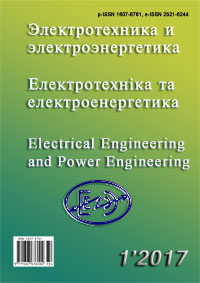DETERMINATION OF THE OPERATING ZONE OF THE PULSE DC VOLTAGE CONVERTER IN THE ELECTROMECHANICAL SYSTEM OF THE WIND POWER PLANT WITH A VARIABLE ROTATION SPEED
DOI:
https://doi.org/10.15588/1607-6761-2017-1-10Keywords:
wind power system, electromechanical system, pulse DC voltage converter, variable rotation speed, graphoanalytical interpretationAbstract
Purpose. Development of the method for matching of the input and output voltage ranges of the pulse DC voltage converter, as part of the electrical equipment of the wind power plant with a variable speed of rotation of the wind turbine shaft.Methods. Graphoanalytical calculation methods, which are also a means of the results visualization for determinate the parameters of the pulse DC voltage converter was offered.
Results. The graph interpretation of the «guaranteed controllability» area, «non-unlocking» area, and «non-locking» area with the help of the grapho-analytical method of matching of the input and output voltage ranges of the pulse dc voltage converter are defined. The first area corresponds to the operation modes of the pulse dc voltage converter, for which a stable operation of the wind turbine with a variable rotation speed of the wind turbine shaft is provided. The second and third areas correspond to the emergency operating modes of the power plant.
Originality. The graphoanalytical interpretation of the converter voltage variation ranges as part of the electromechanical system of the wind power plant, which allows to visually presenting the problem of matching of the operation modes of the wind power plant equipment is offered.
Practical value. The order of matching the ranges of input and output voltages of the pulse DC voltage converter in the structure of the electrical equipment for wind power plant with variable rotation speed of the wind turbine shaft, which allowing to determinate the zone of guaranteed controllability of the wind power plant is proposed
References
Sharmila Deve V., Karthiga, S. (2012). Advanced control techniques in variable speed stand alone wind turbine systen. International Journal of Advances in Engineering & Technology, 3, 1, 549–557.
Bunlung Neammanee, Somporn Sirisumrannukul. (2010). Somchai Chatratana Control Strategies for Variable-speed Fixed-pitch Wind Turbines. Wind Power, INTECH, Croatia, 189–232.
Mahmoud M. Hussein. (2012). Simple Sensorless Maximum Power Extraction Control for A Variable Speed Wind Energy Conversion System. International Journal of Renewable and Sustainable Energy, 10, 1–10.
Dimitrios Bourlis Control Algorithms and Implementation for Variable Speed Stall Regulated Wind Turbines. (2011). PhD dissertation. University of Leicester. URL: https://lra.le.ac.uk/handle/2381/28800
Sharmila, Deve V. (2012). Advanced Control Techniques in Variable Speed Stand Alone Wind Turbine System. International Journal of Advances in Engineering & Technology, 3, 549–557.
Yarymbash, D. S., Kotsur, M. I., Yarymbash, S. T., Kotsur, I. M. (2016). Osobennosti trekhmernogo modelirovaniya elektromagnitnykh poley asinkhronnogo dvigatelya, Elektrotehnika ta elektroenergetika, 2, 43–50. DOI 10.15588/1607-6761-2016-2-5
Alejandro, R., Alvaro, L., Gerardo, V. (2009). Modeling of a Variable Speed Wind Turbine with a Permanent Magnet Synchronous Generator. IEEE International Symposium on Industrial Electronics, 734–739.
Makvana, V. T., Ahir, R. K. (2013). Study of PID Controller Based Pitch Actuator System for Variable Speed HAWT using MATLAB. International Journal of Innovative Research in Science, Engineering and Technology, 2(5), 1496–1504.
Cuesta, A. B., Gomez-Gil, F. J. (2013). Feasibility of a Simple Small Wind Turbine with Variable-Speed Regulation Made of Commercial Components. Energies, 6(6), 3373–3391.
Belghazi, O. (2012). Cherkaoui M Pitch angle control for variable speed wind turbines using genetic algorithm controller. Journal of Theoretical and Applied Information Technology, 39(1), 6–10.
Ofualagba, G., Ubeku, E. (2011). The Modeling and Dynamic Characteristics of a Variable Speed Wind Turbine. Journal of Energy Technologies and Policy, 1(3), 10–22.
Mali, S. S., Kushare, B. E. (2013). MPPT Algorithms: Extracting Maximum Power from Wind Turbines, International Journal Of Innovative Research In Electrical. Electronics, Instrumentation And Control Engineering, 1, 5, 199–202.
Ramakrishnan, V., Srivatsa, S. K. (2012). Pitch Control of Wind Turbine Generator by using New Mechanism, 6, 13, 1–15.
. Chunting, Mi., Mariano Filippa. (2004). Modeling and Control of a Variable-Speed Constant-Frequency Synchronous Generator with Brushless Exciter. IEEE Transactions on Industry Applications, 40, 2, 565–573.
Kotsur M. I. (2014). Osobennosti udarnogo teplovogo vozdeystviya na asinhronnyiy dvigatel s modifitsirovannoy sistemoy impulsnogo regulirovaniya v usloviyah chastyih puskov. Elektrotehnika ta elektroenergetika, 1, 32 – 36. DOI 10.15588/1607-6761-2014-1-5
Novikov, A. M., Novikov, D. A. (2010). Metodologiya nauchnogo issledovaniya, Moscow, Librokom, 280.
Nemudriy, I. Yu. (2015). Pidvischennya efektivnosti elektromehanichnoyi sistemi vitroelektrichnih ustanovok z aerodinamichnoyu multiplikatsieyu: avtoref. dis. na zdobuttya nauk. stupenya kand. tehn. nauk : 05.09.03 Dnipropetrovsk, 20.
Downloads
How to Cite
Issue
Section
License
Copyright (c) 2017 D.G. Alekseevskiy, P. D. Andrienko, K. O. Tyrushev, O. O. Pankova

This work is licensed under a Creative Commons Attribution 4.0 International License.
Creative Commons Licensing Notifications in the Copyright Notices
Authors who publish with this journal agree to the following terms:
Authors retain copyright and grant the journal right of first publication with the work simultaneously licensed under aCreative Commons Attribution License that allows others to share the work with an acknowledgement of the work's authorship and initial publication in this journal.
Authors are able to enter into separate, additional contractual arrangements for the non-exclusive distribution of the journal's published version of the work (e.g., post it to an institutional repository or publish it in a book), with an acknowledgement of its initial publication in this journal.
Authors are permitted and encouraged to post their work online (e.g., in institutional repositories or on their website) prior to and during the submission process, as it can lead to productive exchanges, as well as earlier and greater citation of published work.

